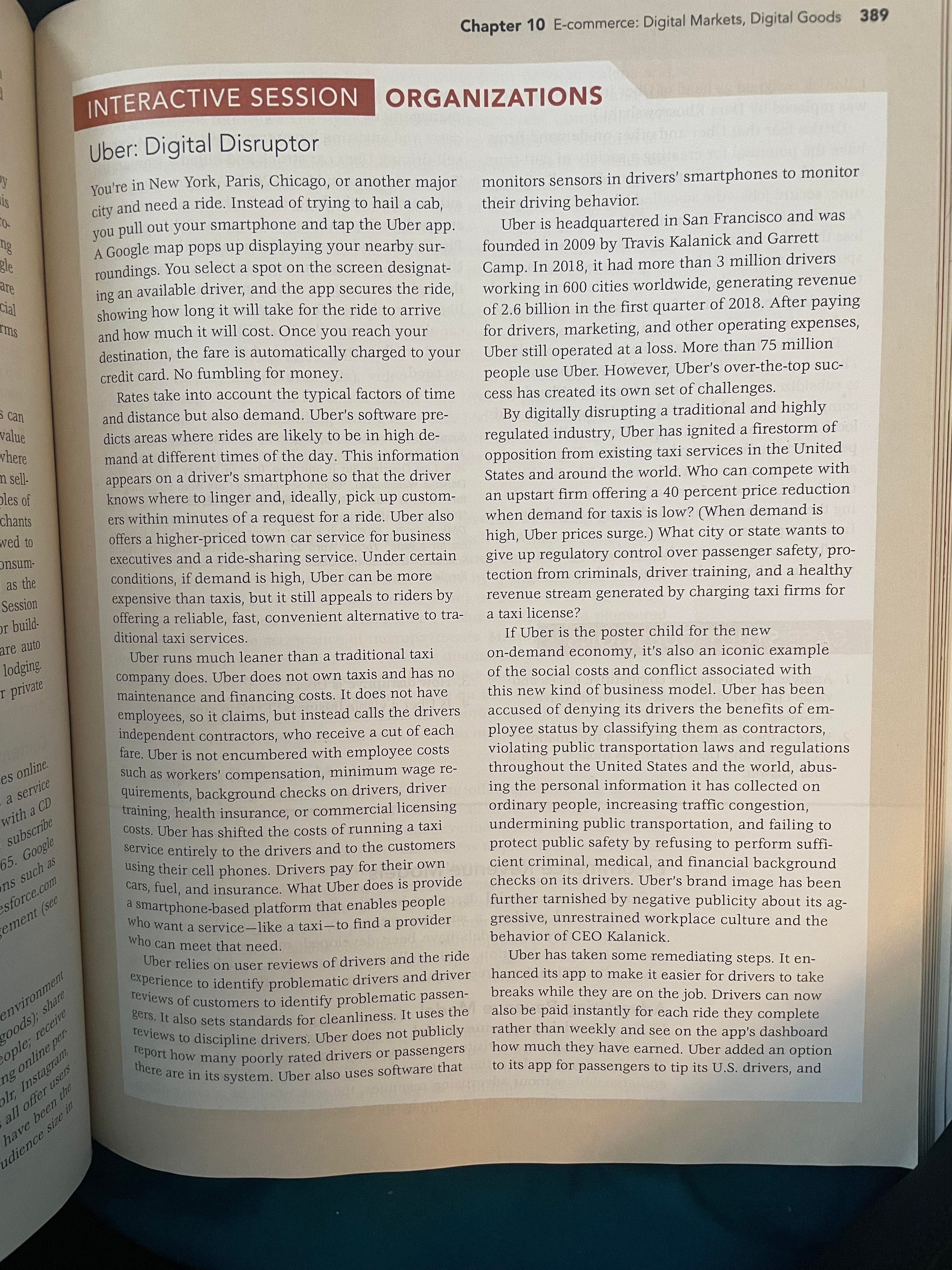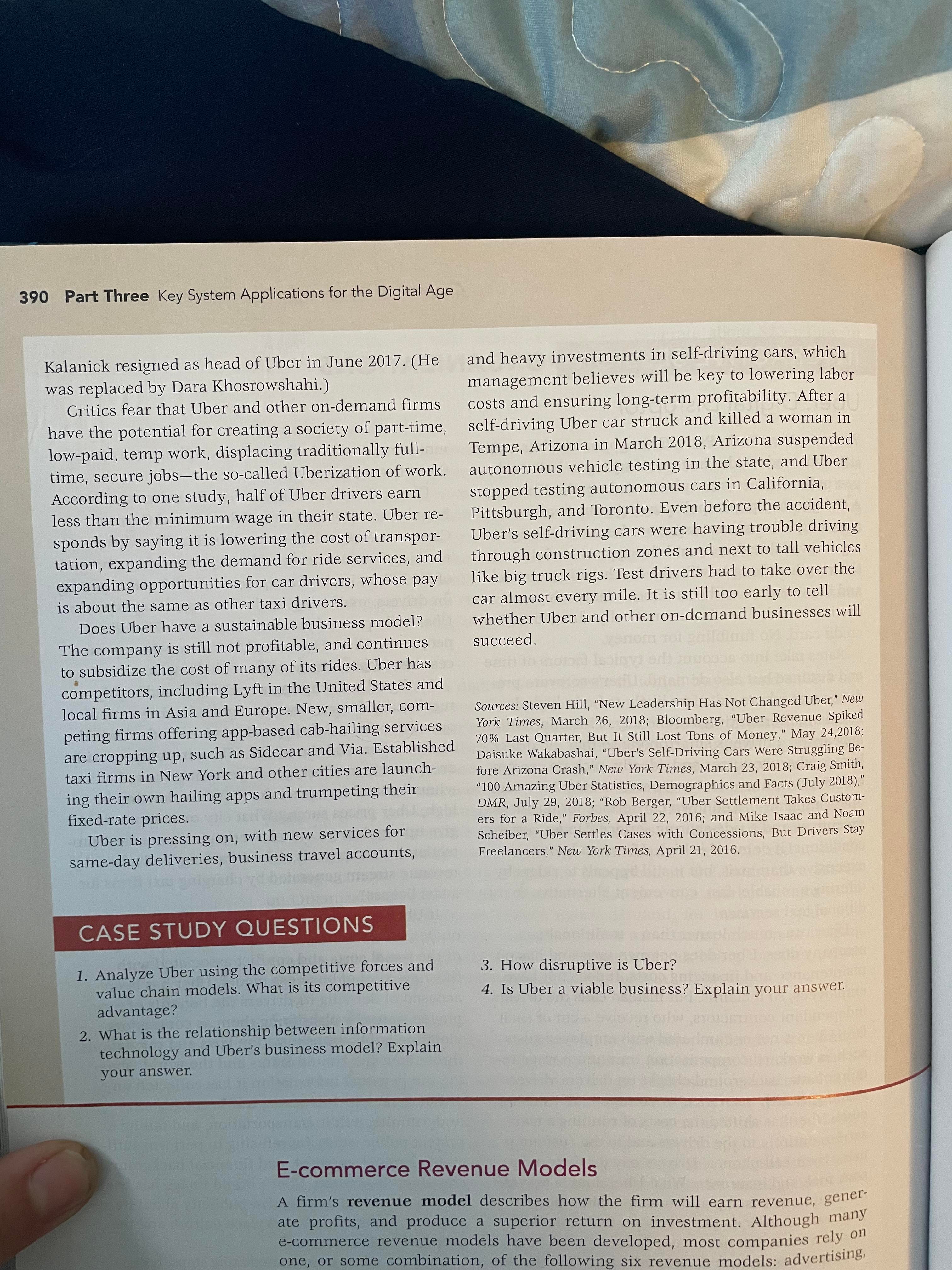Answered step by step
Verified Expert Solution
Question
1 Approved Answer
Chapter 10 E-commerce: Digital Markets, Digital Goods 389 is - ng gle are cial TmS Scan value where m sell- bles of chants wed


Chapter 10 E-commerce: Digital Markets, Digital Goods 389 is - ng gle are cial TmS Scan value where m sell- bles of chants wed to onsum- as the Session or build- are auto lodging. r private es online. a service with a CD subscribe 65. Google ons such as esforce.com ement (see INTERACTIVE SESSION ORGANIZATIONS Uber: Digital Disruptor You're in New York, Paris, Chicago, or another major city and need a ride. Instead of trying to hail a cab, you pull out your smartphone and tap the Uber app. A Google map pops up displaying your nearby sur- roundings. You select a spot on the screen designat- ing an available driver, and the app secures the ride, showing how long it will take for the ride to arrive and how much it will cost. Once you reach your destination, the fare is automatically charged to your credit card. No fumbling for money. Rates take into account the typical factors of time and distance but also demand. Uber's software pre- dicts areas where rides are likely to be in high de- mand at different times of the day. This information appears on a driver's smartphone so that the driver knows where to linger and, ideally, pick up custom- ers within minutes of a request for a ride. Uber also offers a higher-priced town car service for business executives and a ride-sharing service. Under certain conditions, if demand is high, Uber can be more expensive than taxis, but it still appeals to riders by offering a reliable, fast, convenient alternative to tra- ditional taxi services. Uber runs much leaner than a traditional taxi company does. Uber does not own taxis and has no maintenance and financing costs. It does not have employees, so it claims, but instead calls the drivers independent contractors, who receive a cut of each fare. Uber is not encumbered with employee costs such as workers' compensation, minimum wage re- quirements, background checks on drivers, driver training, health insurance, or commercial licensing costs. Uber has shifted the costs of running a taxi service entirely to the drivers and to the customers using their cell phones. Drivers pay for their own cars, fuel, and insurance. What Uber does is provide a smartphone-based platform that enables people who want a service-like a taxi-to find a provider who can meet that need. Uber relies on user reviews of drivers and the ride experience to identify problematic drivers and driver reviews of customers to identify problematic passen- gers. It also sets standards for cleanliness. It uses the reviews to discipline drivers. Uber does not publicly report how many poorly rated drivers or passengers there are in its system. Uber also uses software that environment goods); share eople; receive ng online per polr, Instagram all offer users have been the udience size in monitors sensors in drivers' smartphones to monitor their driving behavior. Uber is headquartered in San Francisco and was founded in 2009 by Travis Kalanick and Garrett Camp. In 2018, it had more than 3 million drivers working in 600 cities worldwide, generating revenue of 2.6 billion in the first quarter of 2018. After paying for drivers, marketing, and other operating expenses, Uber still operated at a loss. More than 75 million people use Uber. However, Uber's over-the-top suc- cess has created its own set of challenges. By digitally disrupting a traditional and highly regulated industry, Uber has ignited a firestorm of ol opposition from existing taxi services in the United States and around the world. Who can compete with an upstart firm offering a 40 percent price reduction when demand for taxis is low? (When demand is high, Uber prices surge.) What city or state wants to give up regulatory control over passenger safety, pro- tection from criminals, driver training, and a healthy revenue stream generated by charging taxi firms for a taxi license? If Uber is the poster child for the new on-demand economy, it's also an iconic example of the social costs and conflict associated with this new kind of business model. Uber has been accused of denying its drivers the benefits of em- ployee status by classifying them as contractors, violating public transportation laws and regulations throughout the United States and the world, abus- ing the personal information it has collected on ordinary people, increasing traffic congestion, undermining public transportation, and failing to protect public safety by refusing to perform suffi- cient criminal, medical, and financial background checks on its drivers. Uber's brand image has been further tarnished by negative publicity about its ag- gressive, unrestrained workplace culture and the behavior of CEO Kalanick. Uber has taken some remediating steps. It en- hanced its app to make it easier for drivers to take breaks while they are on the job. Drivers can now also be paid instantly for each ride they complete rather than weekly and see on the app's dashboard how much they have earned. Uber added an option to its app for passengers to tip its U.S. drivers, and 390 Part Three Key System Applications for the Digital Age Kalanick resigned as head of Uber in June 2017. (He was replaced by Dara Khosrowshahi.) Critics fear that Uber and other on-demand firms have the potential for creating a society of part-time, low-paid, temp work, displacing traditionally full- time, secure jobs-the so-called Uberization of work. According to one study, half of Uber drivers earn less than the minimum wage in their state. Uber re- sponds by saying it is lowering the cost of transpor- tation, expanding the demand for ride services, and expanding opportunities for car drivers, whose pay is about the same as other taxi drivers. Does Uber have a sustainable business model? The company is still not profitable, and continues to subsidize the cost of many of its rides. Uber has competitors, including Lyft in the United States and local firms in Asia and Europe. New, smaller, com- peting firms offering app-based cab-hailing services are cropping up, such as Sidecar and Via. Established taxi firms in New York and other cities are launch- ing their own hailing apps and trumpeting their fixed-rate prices. Uber is pressing on, with new services for same-day deliveries, business travel accounts, and heavy investments in self-driving cars, which management believes will be key to lowering labor costs and ensuring long-term profitability. After a self-driving Uber car struck and killed a woman in Tempe, Arizona in March 2018, Arizona suspended autonomous vehicle testing in the state, and Uber stopped testing autonomous cars in California, Pittsburgh, and Toronto. Even before the accident, Uber's self-driving cars were having trouble driving through construction zones and next to tall vehicles like big truck rigs. Test drivers had to take over the car almost every mile. It is still too early to tell whether Uber and other on-demand businesses will succeed. Sources: Steven Hill, "New Leadership Has Not Changed Uber," New York Times, March 26, 2018; Bloomberg, "Uber Revenue Spiked 70% Last Quarter, But It Still Lost Tons of Money," May 24, 2018; Daisuke Wakabashai, "Uber's Self-Driving Cars Were Struggling Be- fore Arizona Crash," New York Times, March 23, 2018; Craig Smith, "100 Amazing Uber Statistics, Demographics and Facts (July 2018)," DMR, July 29, 2018; "Rob Berger, "Uber Settlement Takes Custom- ers for a Ride," Forbes, April 22, 2016; and Mike Isaac and Noam Scheiber, "Uber Settles Cases with Concessions, But Drivers Stay Freelancers," New York Times, April 21, 2016. CASE STUDY QUESTIONS 1. Analyze Uber using the competitive forces and value chain models. What is its competitive advantage? 2. What is the relationship between information technology and Uber's business model? Explain your answer. 3. How disruptive is Uber? 4. Is Uber a viable business? Explain your answer. E-commerce Revenue Models A firm's revenue model describes how the firm will earn revenue, gener- ate profits, and produce a superior return on investment. Although many e-commerce revenue models have been developed, most companies rely on one, or some combination, of the following six revenue models: advertising,
Step by Step Solution
There are 3 Steps involved in it
Step: 1

Get Instant Access to Expert-Tailored Solutions
See step-by-step solutions with expert insights and AI powered tools for academic success
Step: 2

Step: 3

Ace Your Homework with AI
Get the answers you need in no time with our AI-driven, step-by-step assistance
Get Started


